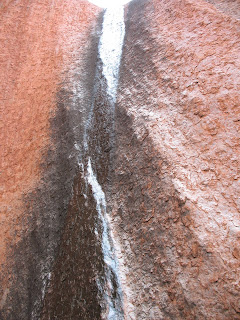
We had successfully determined that the Ayers Rock Resort is not what is real about Uluru. Whatever real experiences were to be found in the dead heart of the country would obviously be found at the rock, as far as possible from the over-priced shuttles, snooty restaurants, and other quotidian concerns at the hotel complex.
We’d already decided not to climb Uluru, but when we got there, we discovered that because it had rained the night before, park rangers had closed the trail to the summit. So nobody would be finding their bliss on top of Uluru that day. We decided to follow ours on the six-mile path that circles the monolith. We knew we didn’t have time to hike the whole path but we started around the rock in a clockwise direction, hoping fervently that Uluru’s reality wasn’t hiding on the far side.
We couldn’t have covered more than two miles, but Uluru had plenty of surprises for us on that short stretch. The path often gets so close to the rock that you can touch it. In places it’s relatively smooth, like granite; in some it’s almost scaly, like slate, and at least one section was full of pits like a meteorite (which people used to think Uluru was—it makes as much intuitive sense as any other explanation).
Much of the rock on this side is eroded by wind at the base, so that there is a low overhang near the path. There are petroglyphs in some of these hollows. In other places, the scoop worn away by the wind is so dramatic that if you stand under the roof, it looks like you’re inside a perfect surfer’s curl that is about to crash on you—it’s a disorienting effect.
One benefit of arriving on one of the 14 days out of the year that it rains is that you get to see the rock’s true color. Uluru normally shows an oxidized rusty red surface. Underneath her blushing exterior, though, Uluru is a gray iron lady. On the day we visited it had rained overnight, and rivulets of water were trickling down the rock. In places, the flow was enough to wash away the red layer. The wet, raw rock underneath showed a metallic spectrum of colors, from platinum to bronze to blue steel.
Pipi and I stopped at one such place. There were a surprising number of trees around—this spot felt like an oasis. At the base of the rock, there was a long shallow pool, almost like a moat between the rock and the path. If I listened very closely, I could just hear water trickling down the rock face and filling up the pool.
While straining to hear the almost imperceptible stream, I realized that as quiet as the sound was, it was the loudest thing I could hear. For the first time in three weeks I was in a place that was almost completely silent. There were no city noises. No train wheels grinding against rails. No wind howling across the Outback. Nobody good-naturedly bellowing, “How ya going?” Even the birds were quiet. Everywhere you go in Australia, even in the urban areas, there is a constant chorus of parrots squawking, mynas chirping, and ravens chortling. But not here. Here was all the cool, calm quiet I hadn’t even realized I was missing.
Suddenly I knew what, for me, was the real thing about Uluru. It was the tranquility. There was peace and quiet all around me, and all I had to do to find it was to take a break from looking for it.
Which certainly made me glad I hadn’t climbed up a thousand-foot mountain in search of it.

No comments:
Post a Comment